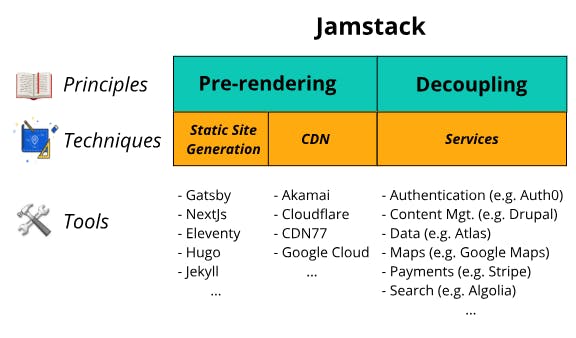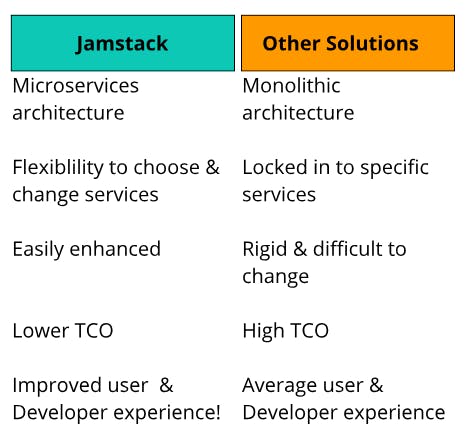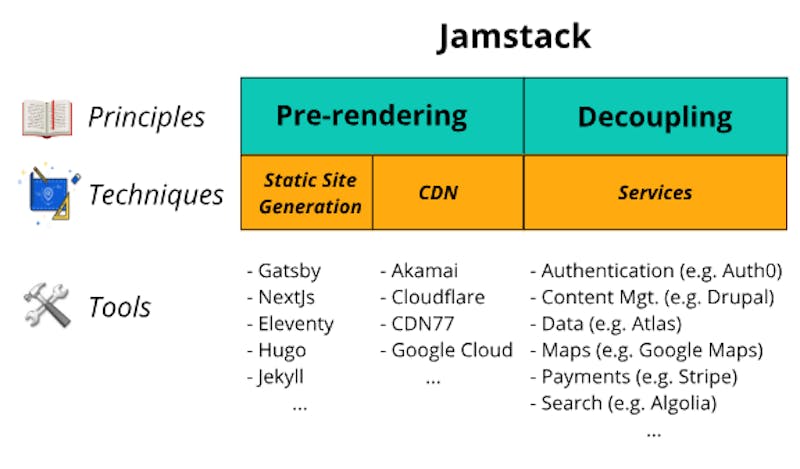Jamstack - An Architecture for Now + the Future
Software Development is a complex and often difficult occupation that requires not only domain-specific knowledge, but also a commitment to continuous learning and improvement. But, as the industry has matured so have the tools and techniques used to develop software.
Tools and techniques like Jamstack, serverless components, headless CMS, and continuous integration/deployment which help Developers quickly build performant and scalable applications.
Developers who are just starting out find Jamstack suitable for quickly and easily building websites as they learn their craft. But the great thing about Jamstack is it’s not something just for starter applications. It’s a technology that scales to support sites of any size.
This is an advantage for new Developers since it means the time invested in learning Jamstack isn’t something that’s thrown away as they become more experienced. It’s an investment that lasts far into the future.
What is Jamstack?
So, what is Jamstack? First and foremost, it is not a single technology, tool, or package. Instead, it’s a set of architectural principles that guide the creation of websites. Jamstack is based on the core concepts of microservices, pre-rendering and decoupling components from one another.

This approach has several key attributes including:
- Security
Using best-of-breed solutions and services simplifies the overall architecture to reduce the attack surface, which also reduces risk. In addition, using pre-rendered read-only content reduces the attack surface even more by limiting the number of possible attack vectors which bad actors can exploit.
- Scalability
Caching content in a content delivery network (CDN) duplicates content across nodes within the CDN to support a higher number of concurrent users. With many, if not all, CDN’s, this has a positive impact to users regardless of their global location.
- Performance
Caching content across nodes in a CDN places it closer to end-users to minimize latency. Since latency is a major contributor to poor performance this is a key advantage over serving pages from a single server.
Pre-rendering web pages also improve performance since pages are generated at build time rather than dynamically each time users request a page.
- Maintainability
The simplified architecture that comes from a microservices-based approach rather than a “not invented here” strategy lowers the total cost of ownership (TCO). Most notably, leaner staffing devoted to developing, enhancing, and maintaining the website.
- Portability
Pre-rendering has another benefit! It means your sites can take advantage of simpler static hosting solutions. This makes it easier to find hosts for your website, but it also makes it easier to move between hosts as you adapt to changing business and technical situations.
Why use Jamstack for your website?

Now that you know what Jamstack is, what makes it the right technology for your websites? The main benefits are security and the ability to scale up and down, but just as important is the increased productivity it provides to Developers.
Reasons to use Jamstack fall broadly into the categories of flexibility, focus, extensibility, reliability, and cost
- Flexibility
Relying on off-the-shelf, best-of-breed services for common problems decreases the amount of custom code needed to support the site. But, it has the added advantage of relying on a service provider with deep domain-specific knowledge and a development team that keeps up with changes and advances within that domain. In many cases, the knowledge and capabilities of an individual service provider are well beyond the capabilities of the average Developer.
The flexibility to choose from a variety of competing services also brings the ability to replace one service for another. Being agile means adapting to changing conditions which may include cost, service levels, and feature competition.
- Focus
Another advantage of relying on external services is it allows you to focus on the unique functionality in your website. The old adage “A jack of all trades is a master of none...” holds true in this case.
The time saved by not having to code, test, document, and deploy important, but routine functionality such as authentication can instead be directed to “creating a better mousetrap”.
- Extensibility
The microservices approach followed by Jamstack directly translates into a more extensible application.
Applications are easier to develop and enhance, faster to deploy, easier to maintain and debug, and are scalable.
This is the result of simpler, modularized functionality with cleaner interfaces between modules and the ability to reuse different components in new ways. Microservices also opens up the potential of running different functions in parallel to achieve performance gains that would be difficult, if not impossible, to achieve in a monolithic architecture.
- Reliability
Duplicating application instances across a CDN not only increase performance and scalability but also
significantly lowers risk since the application is duplicated across the Internet.
The practical advantage is the outage of a single instance only impacts a portion of the users rather than all users, as is the case in a single server implementation.
However, even more benefit comes from using services rather than custom code. A smaller custom codebase and cleaner interfaces make the application easier to test, debug, and maintain. Less code means fewer bugs and fewer outages, and also makes it easier to follow development best practices to improve quality.
- Cost
Using CDN’s, off-the-shelf services, and reducing the amount of time required to build and maintain
applications yield a lower total cost of ownership (TCO).
How is Jamstack different from other solutions?

There are other solutions for creating websites and delivering content besides Jamstack. These include content management systems (CMS’s), website generators, and hybrid solutions like WordPress.
But despite their usefulness, they still rely on a monolithic approach rather than microservices. This means they are more rigid than Jamstack since they lock developers into a specific solution. This makes it more difficult and costly to exchange one solution for another, which increases time and cost.
This rigidity and lack of modularity have the effect of “locking” developers into a particular vendor who may prioritize new and improved features in a manner that doesn’t meet your needs! The microservices approach used by Jamstack places you in control of priorities so you have the ability to choose the most effective solution for your specific needs.
Unlike Jamstack, traditional solutions have a traditional technical stack requiring infrastructure and staff with specialized expertise. The Jamstack approach reduces or eliminates these dependencies, which in turn, lowers TCO.
As we’ve seen, Jamstack has many benefits, but it also significantly improves the experience of both Users and Developers allowing new websites to be delivered faster and cheaper than with other architectures. Similarly, this is also true for enhancements and fixes to existing sites as well.
Jamstack gives Developers the freedom to concentrate on delivering high-quality, performant solutions to users without the overhead and frustrations associated with monolithic solutions.
Conclusion
Jamstack isn’t just another overhyped solution. It was started in 2015 and over the last six years has been adopted by developers and vendors alike.
The State of the Jamstack Survey 2020 revealed that 36% of respondents had 4 years or less of experience, but 38% had an average of 8 years experience. This shows that Jamstack is maturing, but continues to be adopted by both new and experienced Developers.
It’s also being accepted in the corporate world as indicated by 35% of the respondents who are using it for enterprise websites and 45% using it to create consumer websites.
Even more telling is the fact that 62% of Jamstack developers don’t work for pure technology companies. They are developing solutions using Jamstack to create a wide variety of applications including Advertising & Marketing, Education, Media & Publishing, Finance, and Business Support and Logistics.
As you can see Jamstack is a solution not only for today’s websites, but also a solution for the future!
